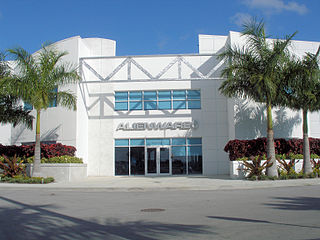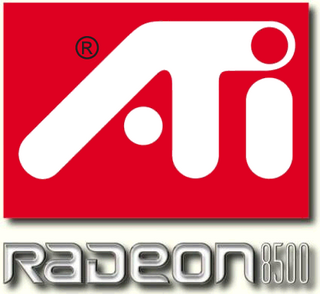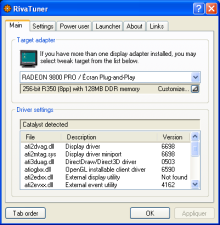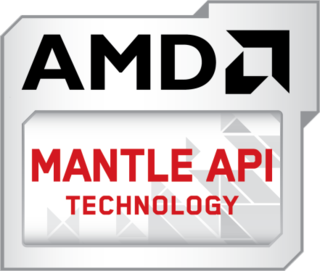
Nvidia Corporation, commonly known as Nvidia, is an American multinational technology company incorporated in Delaware and based in Santa Clara, California. It is a software and fabless company which designs graphics processing units (GPUs), application programming interface (APIs) for data science and high-performance computing as well as system on a chip units (SoCs) for the mobile computing and automotive market. Nvidia is a global leader in artificial intelligence hardware and software. Its professional line of GPUs are used in workstations for applications in such fields as architecture, engineering and construction, media and entertainment, automotive, scientific research, and manufacturing design.

A graphics card is an expansion card which generates a feed of output images to a display device. Frequently, these are advertised as discrete or dedicated graphics cards, emphasizing the distinction between these and integrated graphics. At the core of both is the graphics processing unit (GPU), which is the main component that performs computations, but should not be confused with the graphics card as a whole, although "GPU" is often used as a metonymic shorthand to refer to graphics cards.

GeForce is a brand of graphics processing units (GPUs) designed by Nvidia. As of the GeForce 30 series, there have been seventeen iterations of the design. The first GeForce products were discrete GPUs designed for add-on graphics boards, intended for the high-margin PC gaming market, and later diversification of the product line covered all tiers of the PC graphics market, ranging from cost-sensitive GPUs integrated on motherboards, to mainstream add-in retail boards. Most recently, GeForce technology has been introduced into Nvidia's line of embedded application processors, designed for electronic handhelds and mobile handsets.

In computing, overclocking is the practice of increasing the clock rate of a computer to exceed that certified by the manufacturer. Commonly, operating voltage is also increased to maintain a component's operational stability at accelerated speeds. Semiconductor devices operated at higher frequencies and voltages increase power consumption and heat. An overclocked device may be unreliable or fail completely if the additional heat load is not removed or power delivery components cannot meet increased power demands. Many device warranties state that overclocking or over-specification voids any warranty, however there are an increasing number of manufacturers that will allow overclocking as long as performed (relatively) safely.

A graphics processing unit (GPU) is a specialized electronic circuit designed to manipulate and alter memory to accelerate the creation of images in a frame buffer intended for output to a display device. GPUs are used in embedded systems, mobile phones, personal computers, workstations, and game consoles.

Alienware is an American computer hardware subsidiary of Dell. Their product range is dedicated to gaming computers which can be identified by their alien-themed designs. Alienware was founded in 1996 by Nelson Gonzalez and Alex Aguila, and is currently led by Vivian Lien. The development of the company is also associated with Frank Azor, Arthur Lewis, Joe Balerdi, and Michael S. Dell. The company's corporate headquarters is located in The Hammocks, Miami, Florida.

Scalable Link Interface (SLI) is a brand name for a deprecated multi-GPU technology developed by Nvidia for linking two or more video cards together to produce a single output. SLI is a parallel processing algorithm for computer graphics, meant to increase the available processing power.

The R200 is the second generation of GPUs used in Radeon graphics cards and developed by ATI Technologies. This GPU features 3D acceleration based upon Microsoft Direct3D 8.1 and OpenGL 1.3, a major improvement in features and performance compared to the preceding Radeon R100 design. The GPU also includes 2D GUI acceleration, video acceleration, and multiple display outputs. "R200" refers to the development codename of the initially released GPU of the generation. It is the basis for a variety of other succeeding products.

A free and open-source graphics device driver is a software stack which controls computer-graphics hardware and supports graphics-rendering application programming interfaces (APIs) and is released under a free and open-source software license. Graphics device drivers are written for specific hardware to work within a specific operating system kernel and to support a range of APIs used by applications to access the graphics hardware. They may also control output to the display if the display driver is part of the graphics hardware. Most free and open-source graphics device drivers are developed by the Mesa project. The driver is made up of a compiler, a rendering API, and software which manages access to the graphics hardware.

The Radeon R100 is the first generation of Radeon graphics chips from ATI Technologies. The line features 3D acceleration based upon Direct3D 7.0 and OpenGL 1.3, and all but the entry-level versions offloading host geometry calculations to a hardware transform and lighting (T&L) engine, a major improvement in features and performance compared to the preceding Rage design. The processors also include 2D GUI acceleration, video acceleration, and multiple display outputs. "R100" refers to the development codename of the initially released GPU of the generation. It is the basis for a variety of other succeeding products.
UNIGINE is a proprietary cross-platform game engine developed by UNIGINE Company, used in simulators, virtual reality systems, serious games and visualization. UNIGINE can support large open worlds including entire planets. It has an advanced 3D renderer that supports OpenGL 4 and DirectX 11. UNIGINE SDK releases an update every three to four months.

RivaTuner is a freeware overclocking and hardware monitoring program that was first developed by Alexey Nicolaychuk in 1997 for the Nvidia video cards. It was a pioneering application that influenced the design of subsequent freeware graphics card overclocking and monitoring utilities. It supports nVidia GPUs from the Riva TNT to the GeForce 700 Series, and also has limited support for the ATI/AMD Radeon series of video cards from the Radeon 8500 and above.
Direct2D is a 2D vector graphics application programming interface (API) designed by Microsoft and implemented in Windows 10, Windows 8, Windows 7 and Windows Server 2008 R2, and also Windows Vista and Windows Server 2008.
UNIGINE Company is a multinational software development company headquartered in Clemency, Luxembourg. It is well known for developing the UNIGINE Engine proprietary cross-platform middleware and advanced GPU benchmarks.
Radeon X800 is a series of graphics cards designed by ATI Technologies Inc. introduced in May of 2004.
The R200 is the second generation of GPUs used in Radeon graphics cards and developed by ATI Technologies. This GPU features 3D acceleration based upon Microsoft Direct3D 8.1 and OpenGL 1.3, a major improvement in features and performance compared to the preceding Radeon R100 design. The GPU also includes 2D GUI acceleration, video acceleration, and multiple display outputs. "R200" refers to the development codename of the initially released GPU of the generation. It is the basis for a variety of other succeeding products.

Mantle was a low-overhead rendering API targeted at 3D video games. AMD originally developed Mantle in cooperation with DICE, starting in 2013. Mantle was designed as an alternative to Direct3D and OpenGL, primarily for use on personal computers, although Mantle supports the GPUs present in the PlayStation 4 and in the Xbox One. In 2015, Mantle's public development was suspended and in 2019 completely discontinued, as DirectX 12 and the Mantle-derived Vulkan rose in popularity.

The GeForce 20 series is a family of graphics processing units developed by Nvidia. Serving as the successor to the GeForce 10 series, the line started shipping on September 20, 2018, and after several editions, on July 2, 2019, the GeForce RTX Super line of cards was announced.

The GeForce 30 series is a family of graphics processing units developed by Nvidia, succeeding the GeForce 20 series. The series was announced on September 1, 2020 and started shipping on September 17, 2020. The cards are based on the Ampere architecture and feature hardware-accelerated raytracing (RTX) with Nvidia's second-generation RT cores and third generation Tensor Cores.
Superposition Benchmark is benchmarking software based on the UNIGINE Engine. The benchmark was developed and published by UNIGINE Company in 2017. The main purpose of software is performance and stability testing for GPUs. Users can choose a workload preset, Low to Extreme, or set the parameters by custom. The benchmark 3D scene is an office of a fictional genius scientist from the middle of the 20th century. The scene is GPU-intensive because of SSRTGI, proprietary dynamic lighting technology by Unigine.











